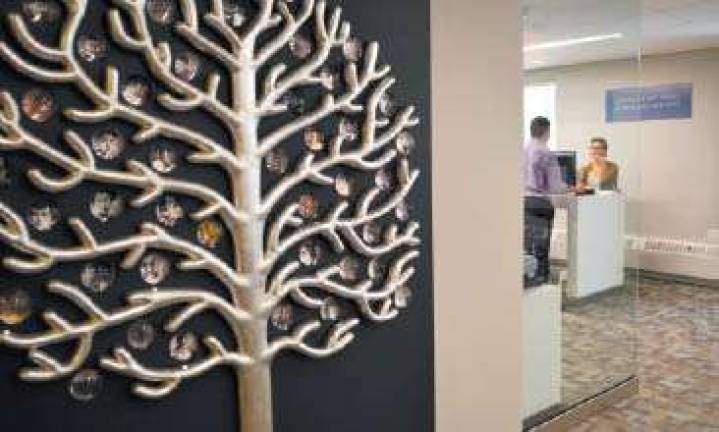Searching for Names and Finding A World

A reporter delves into newly-available resources for searching for clues to ancestry
Union Square Inside the Ackman & Ziff Family Genealogy Institute at the Center for Jewish History on 16th Street, an orderly calm masks the intensity of personal discovery.
Visitors use desktop computers to access databases of family names and places of origin, and microfilm readers to examine hand- and typewritten documents. Most pursue their work quietly, but sometimes, the effect of the research is clear.
"We had someone for whom we found an immigration document for her grandfather, and she was named after this person," said Laura Leone, the director of archive and library services at the center. "Her eyes popped out of her head."
The newly renovated institute, along with the adjoining Lillian Goldman Reference Division and Reading Room, serve as the entrance point to the physical archives of the center's five partners: the American Jewish Historical Society, the American Sephardi Federation, the Leo Baeck Institute, Yeshiva University Museum, and the YIVO Institute for Jewish Research. Altogether, the partners' collections consist of approximately 500,000 texts and over 100 million documents and multimedia artifacts, including scholarly works, memoirs, letters, flyers, and photographs, mostly housed on eight floors on the 17th Street side of the building.
Leone said that family history searches that begin with names in the institute can lead to books and other resources in the reading room.
"Some people come in and they want to fill out their family tree and that's it," she said. "But some people want the larger context. They want to know about the town their great-grandfather was from, the major trades, they want to know exactly what Jewish life was like."
According to Miriam Haier, the senior manager for communications and publications at the center, family history has grown more popular since the genealogy institute opened in 2000. The new space, which opened on May 12, features touchscreen computers with wireless keyboards, more room for visitors and reference staff to spread out and conduct one-on-one sessions, and sliding glass doors that comply with the Americans with Disabilities Act.
Artwork, design, and décor help bring the purpose of the institute, reference division, and reading room into focus. The artist Diane Samuels composed her map, "The Written World," with pieces of dyed, handmade paper depicting letters and characters from materials within the collections; it hangs by the entrance to the reading room. The Manhattan design firm Pure and Applied made a silver-colored sculpture of a tree with archival photographs of families, couples and children arranged among its branches; it stands by the door of the institute.
Even the carpet, a repeating pattern of Tetris-like forms in shades of gray, suggests the interlocking nature of human ancestry.
The center welcomes people of all backgrounds to do genealogical research, study archival material, or peruse exhibitions on Jewish history. Last week, near the end of a series of events marking the reopening of the institute, I walked in with my notebooks, pens, and a few names.
My mother's family comes from Oran, a city on the Mediterranean coast of Algeria. They moved to Paris in 1960 during the Algerian War of Independence, and she married my father, an American, near Boston in 1972. I grew up with the Red Sox, MTV, and a half-French identity rooted in Europe. But as an adult, mom's occasional reminiscences of the beaches she enjoyed as a child have grown more important.
There was her father, who sold specialty foods and wine: an Eruimy. Her mother, who married him according to custom after his first wife, her older sister, died: a Benayche. And her grandmother: a Chouraqui. Plus an additional clue: the Benayches came from Tetouan, a city in Morocco.
David Rosenberg, the reference services research coordinator in the reading room, met me for a morning appointment. He introduced me to JD Arden, a reference assistant in the institute. Together, we sat at computers and visited SephardicGen, a website devoted to the Jews of Southern Europe, North Africa, and the Middle East.
We looked for Eruimy, then Ruimy-names, I learned, have various spellings, and databases permit searches based on phonetics-and found the latter in a list of Moroccan names.
"Same neighborhood," Arden said, knowing I expected to find it on an Algerian list.
Nothing for Benayche, but Chouraqui lit up the screen. We opened the center's website and searched for it there, too, and found a 1968 book by André Chouraqui called "Between East and West: A History of the Jews of North Africa," in the collection of the American Sephardi Federation.
That book, and a 2011 collection of articles entitled "Jewish Culture and Society in North Africa," kept me occupied for the rest of the day. I didn't know that attacks against Jews in Tetouan helped cause migration to Oran; I didn't know that Algerian Jews gained their French citizenship via the Crémieux Decree in 1870.
As I read, I felt the knowledge of my forebears' world warming my body. I felt closer to the beaches that my mother hasn't visited since she left Algeria, and that I have yet to see.